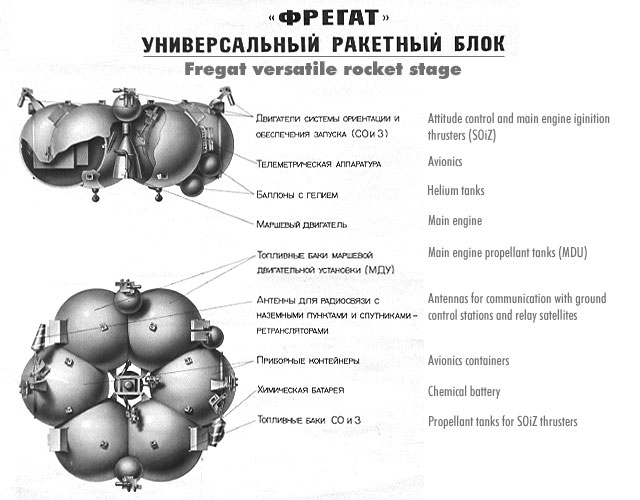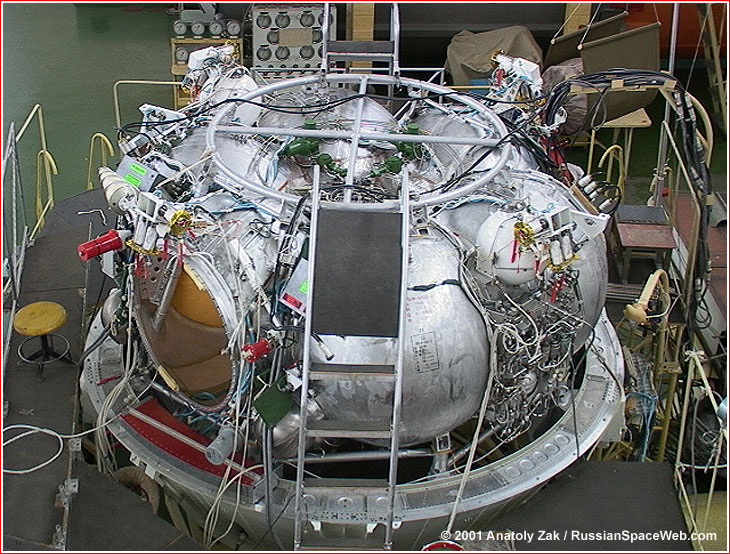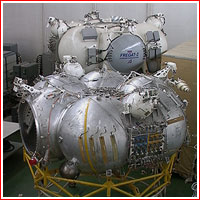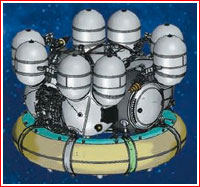|
Fregat upper stage
Entering service at the turn of the 21st century, the Fregat (frigate) became the main fourth stage for the Soyuz family of rockets flying from four launch sites around the world. The Fregat was also adapted as a third stage of the Zenit rocket for some of its most critical missions.

The high-performance Fregat space tug originated as a propulsion stage for the Soviet Mars probes. It was later adapted for many deep-space missions, thanks to its ability to fire its engine multiple times and function in space for prolonged periods.
Technical specifications of the Fregat upper stage (118; 207):
| Fueled mass |
6,415 - 6,535 kilograms (Fregat-MT: 7.5 tons) |
Dry mass |
980 - 1,100 kilograms |
| Height |
1,500 millimeters |
| Diameter |
3,350 millimeters |
| Fuel |
UDMH (Unsymmetrical dimethyl hydrazine) |
| Oxidizer |
NTO (Nitrogen tetroxide) |
| Maximum propellant load for main engine |
5,350 kilograms |
| Main engine |
S5.92 |
| Thrust |
2,000 kilograms |
| Specific impulse |
327 - 328.5 seconds |
| Number of engine firings |
up to 20 |
| Propellant load (one component: hydrazine) for the attitude control system, RSU |
85 kilograms (in 2012 reported as 63 kilograms) |
| Number of attitude control thrusters |
12 |
| Thrust of attitude control engines |
5 kilograms |
| Specific impulse of the attitude control system |
225 seconds |
Formally, the development of the Fregat upper stage started around 1991 or 1992 in conjunction with the Rus project, envisioning a series of upgrades of the Soyuz rocket family. The Fregat was expected to serve as a fourth (upper) stage for the Soyuz-2 rocket, delivering payloads from low "parking" orbits into various high-altitude orbits or sending planetary probes into deep space. Potentially, Fregat could be adapted to serve as the third stage of the Soyuz rocket, instead of Block I stage, to form the Vostok-2/Fregat booster. In such configuration, the rocket could launch cargo into low- and mid-altitude orbits, as well as into sun-synchronous orbits.
Finally, Fregat could become the third stage of the Zenit rocket, or the fifth stage of the Proton M/Block D combination. When combined with Block D onboard the Proton, Fregat could deliver 3,500 kilograms of payload into geostationary orbit, compared to 2,600 kilograms without it.
NPO Lavochkin claimed that Fregat's performance characteristics would exceed those of any contemporary vehicle. The stage inherited many of its components from previous Soviet hardware, reducing the development cost and increasing the overall reliability of the system.
Design features

The Fregat's exotic architecture traces its roots in the Soviet lunar probes developed at NPO Lavochkin in the 1960s. The stage is made up of six overlapping spherical sections, only four of which serve as propellant tanks. Two remaining spheres are actually instrument sections, one containing unpressurized avionics, which can function in vacuum of space and another, pressurized section, holding a flight control computer, which requires a temperature-controlled environment.
At least four spherical gas tanks with a diameter of 375 millimeters and a capacity of 23 liters are carried onboard Fregat.
The main propulsion unit of the Fregat upper stage consists of a single S5.92 engine. Capable of multiple firings and dual-thrust mode, it uses a turbo-pump and operates in a gas-generator cycle. The stage has also a single-component attitude control system, SOiZ, which has its own propellant cache of between 63 and 85 kilograms of hydrazine. The small engines of the SOiZ system have a thrust of five kilograms and specific impulse of 225 seconds.
The "flat" architecture of Fregat allowes to minimize its mass and the inertia to be overcome during engine firings. As a result, developers can place the main engine of the ADU on special rail guides instead of a gimbal mechanism in order to steer the thrust of the propulsion system.
According to the Technical Project developed in the 1990s, the main propulsion system aboard Fregat was supposed to have an protective cover to address thermal requirements during a passive flight lasting from 1.5 hours up to 10 days. The electrically driven cover would swing 150 degrees to expose the main nozzle ahead of each maneuver. However, because Fregat ended up operating at the lower end of the projected temperature range in most launches during missions lasting a few hours, the developer made a decision to remove the thermal cover in 2002, after three launches. An extra package of batteries, known as KhIT (from Chemical Current Source) was removed as as well to save mass. However, the thermal cover was retained in the design of the Fregat derivative, known as the Main Propulsion System, MDU, developed for the Phobos-Grunt project.
Technical specifications of the S5.92 engine used on Fregat upper stage (340):
Thrust in vacuum |
1,400 kilograms and 2,000 kilograms |
Specific Impulse |
323 seconds and 329 seconds |
Propellant component ratio |
2.05 and 1.95 |
Thrust development time (to 90 percent from nominal) |
2.5 - 3.0 seconds |
Duration of firing |
1,350 seconds |
Restart capability |
25 times |
Engine gimbal capability (yaw and pitch) |
±300 millimeters |
Engine dry mass |
75 kilograms |
Engine dimensions |
677 x 838 x 1,028 millimeters |
Life span in orbit |
Three years |
Fregat variants
The successful operation of the Fregat stage spurred a number of its upgrades for the the Soyuz and other launch vehicles.
Fregat SB
NPO Lavochkin proposed the Fregat-2 version of the upper stage equipped with a jettisonable external tank. When launched on a Zenit rocket, Fregat-2 could deliver 2,300 kilograms of payload into the geostationary orbit, while in combination with the Proton M rocket, 4,000 kilograms could be inserted into the same orbit. (118) The vehicle was later renamed Fregat-SB, where SB stands for "sbrasyvaemye baki" or "jettisonable tanks," and its first mission was scheduled to be the launch of the Spektr-R scientific satellite onboard a Zenit-3M rocket. Routine preflight processing of the vehicle was planned at the assembly building at Site 31 in Baikonur.
Fregat-M/Fregat-MT
Yet another unique modification of the Fregat upper stage was developed specifically for the Phobos-Grunt mission. It was dubbed Flagman and it also featured a jettisonable external tank, as well as additional ball-shaped inserts on the upper hemispheres of the propellant tanks. Similar tank extensions were added to the particular versions of Fregat meant to fly on the Soyuz-ST rocket from Kourou, such as those intended to carry Europe's Galileo navigation satellites. This version of the stage was identified as Fregat-MT. According to unofficial sources, propellant tank inserts enabled to increase the propellant load from 5,350 kilograms to 6,640 kilograms, without any changes in the critical physical dimensions of the vehicle. In the meantime, Arianespace officials confirmed that some preliminary consideration had been given to equipping Europe's flagship Ariane-5 rocket with Fregat in order to fly trajectories, which would require multiple firings of an upper stage in space.
Fregat-SBU
During an expanded session of the Scientific and Technical Council, NTS, on May 29, 2018, Sergei Ishin, Deputy Designer General, presented plans for the Fregat-SBU variant, which would be adapted for the Soyuz-5 and Angara-3 launch vehicles. According to NPO Lavochkin, the council approved the development of the Fregat-SBU variant, but not much was heard about the project after that.
Flagman
At the turn of the 21st century, NPO Lavochkin considered the Flagman two-stage space tug, which would combine the 11S824M upper stage (Block-D) and Fregat, serving as the second stage. The combo was apparently intended for placing satellites directly into the geostationary orbit, GSO. The space tug could deliver 3,100 kilograms of cargo on the Proton rocket or 3,500 kilograms either on Proton-M flying from Baikonur or an Angara-5 rocket based in Plesetsk.
Fregat-M/Fregat-MT specifications (410):
| Total (dry) mass |
920 kilograms |
1,030 kilograms |
| Maximum propellant load |
5,250 kilograms |
6,550 kilograms |
| Height |
1.55 meters |
- |
| Maximum diameter |
3.35 meters |
3.38 meters |
| Engine thrust (high-thrust mode) |
2,000 kilograms |
- |
| Engine thrust (low-thrust mode) |
1,400 kilograms |
- |
| Specific impulse |
333.2 seconds |
- |
| Number of possible engine firings |
7 |
- |
In-flight problems
In 2012, posters in the Novosti Kosmonavtiki web forum reported that during the mission to deliver the COROT space observatory, the Fregat upper stage had experienced problems. As it transpired, a valve tasked to reduce pressurization of propellant tanks from 320 bars to 38 bars had leaked. As a result, the pressurization system worked below specifications during the mission, failing to provide needed pressure into the propellant tanks during the Fregat maneuvers. Fortunately, it was still enough to deliver propellant for all firings of the main engine and keep the vehicle on the right trajectory. A similar problem took place onboard Fregat during the launch of the Globalstar satellites on May 30, 2007.
The investigation later concluded that specific design of the valve and the loss of flexibility in its membrane had been likely culprits. One source claimed that KBKhM design bureau, which built the Fregat's propulsion system possible used a new materials, later reverted back to previous design, thus solving the problem.
Production rates and upgrades
In 2011, NPO Lavochkin built 12 Fregat stages, 11 of which were expended during missions. The production of 10 more stages was ordered during 2012, while nine stages were scheduled to fly, including three on the Soyuz rockets from French Guiana. NPO Lavochkin reconfirmed the annual production rate of 12 Fregat stages again in May 2018.
Starting with the Ionosfera-M mission in 2024, Fregat was expected to be equipped with a new flight control system with strapdown complex of command instruments, KKP. The modifed flight control system was indeed introduced during the launch of Fregat No. 142-02, however the transition to the KKP instruments had to be postponed.
The complete list of Fregat missions:
| 1 |
2000 Feb. 9 |
Demonstrator, IRDT |
Experimental |
Soyuz-U |
|
31 |
6 |
Success |
| 2 |
2000 March 20 |
Dumsat |
Experimental |
Soyuz |
Baikonur |
31 |
6 |
Success |
| 3 |
2000 July 16 |
Cluster-2 (5-6) |
Science |
Soyuz |
Baikonur |
31 |
6 |
Success |
| 4 |
2000 Aug. 9 |
Cluster-2 (7-8) |
Science |
Soyuz |
Baikonur |
31 |
6 |
Success |
| 5 |
2003 June 2 |
Mars Express / Beagle-2 |
Planetary / Mars |
|
Baikonur |
31 |
6 |
Success |
| 6 |
2003 Dec. 28 |
Amos-2 |
Application / communications |
Soyuz-FG |
Baikonur |
31 |
6 |
Success |
| 7 |
2005 Aug. 14 |
Galaxy-14 |
Application / communications |
Soyuz-FG |
Baikonur |
31 |
6 |
Success |
| 8 |
2005 Nov. 14 |
Venus-Express |
Planetary / Venus |
Soyuz-FG |
Baikonur |
31 |
6 |
Success |
| 8 |
2005 Dec. 28 |
GSTB-V/2A |
Application / navigation |
Soyuz-FG |
Baikonur |
31 |
6 |
Success |
| 10 |
2006 Oct. 19 |
|
Application / remote sensing |
|
|
|
6 |
Success |
| 11 |
2006 Dec. 24 |
|
Military / communications |
|
|
|
4 |
Success |
| 12 |
2006 Dec. 17 |
|
Science / astronomy |
|
|
|
6 |
Success |
| 13 |
2007 May 30 |
Globalstar (4) |
Application / communications |
Soyuz-FG |
Baikonur |
31 |
6 |
Success |
| 14 |
2007 Oct. 21 |
Globalstar (4) |
Application / communications |
Soyuz-FG |
Baikonur |
31 |
6 |
Success |
| 15 |
2007 Dec. 14 |
Radarsat-2 |
Application / remote sensing |
Soyuz-FG |
Baikonur |
31 |
6 |
Success |
| 16 |
2008 April 27 |
GIOVE-B |
Application / navigation |
Soyuz-FG |
Baikonur |
31 |
6 |
Success |
| 17 |
2009 May 22 |
|
Military / communications |
|
|
|
4 |
Failure* |
| 18 |
2009 Sept. 17 |
|
Application / remote sensing |
|
|
31 |
6 |
Success |
| 19 |
2010 Oct. 19 |
Globalstar-2 (1-6) |
Application / communications |
|
|
31 |
6 |
Success |
| 20 |
2010 Nov. 2 |
|
|
|
|
43 |
4 |
Success |
| 21 |
2011 Jan. 20 |
|
Application / remote sensing |
|
|
|
- |
Success |
| 22 |
2011 Feb. 26 |
|
Navigation |
|
|
43 |
4 |
Success |
| 23 |
2011 May 4 |
Meridian (4) |
|
|
|
43
|
4
|
Success |
| 24 |
2011 July 13 |
Globalstar-2 (6) |
Communications |
|
|
|
6
|
Success |
| 25 |
2011 July 18 |
|
|
|
|
|
-
|
Success |
| 26 |
2011 Oct. 3 |
|
Navigation |
|
|
43 |
4 |
Success |
| 27 |
2011 Oct. 21 |
|
Navigation |
Soyuz-ST-B |
|
|
- |
Success |
| 28 |
2011 Nov. 28 |
GLONASS-M (Kosmos-2478) |
Application / navigation |
|
|
43 |
4 |
Success |
| 29 |
2011 Dec. 17 |
|
Military |
|
|
|
- |
Success |
| 30 |
2011 Dec. 23 |
|
|
|
|
|
4 |
Success |
| 31 |
2011 Dec. 28 |
|
Applications / Communications |
|
|
|
6 |
Success |
| 32 |
2012 July 22 |
|
|
|
|
|
6 |
Success |
| 33 |
2012 Sept. 17 |
|
Application / weather forecasting |
|
|
|
6 |
Success |
| 34 |
2012 Oct. 12 |
|
Application/navigation |
|
|
|
- |
Success |
| 35 |
2012 Nov. 14 |
|
|
|
|
|
4 |
Success |
| 36 |
2012 Dec. 1 |
|
Military / remote-sensing |
|
|
|
- |
Success |
| 37 |
2013 Feb. 6 |
Globalstar-2 (FM19, FM20, FM21, FM22, FM23, FM24) |
Application / communications |
|
|
|
6
|
Success |
| 38 |
2013 April 26 |
|
Application / navigation |
|
|
|
4
|
Success |
| 39 |
2013 June 25 |
|
|
|
|
|
-
|
Success |
| 40 |
2013 Dec. 19 |
|
|
|
|
|
- |
Success |
| 41 |
2014 March 24 |
|
|
|
|
|
4 |
Success |
| 42 |
2014 April 3 |
|
Application / remote sensing |
|
|
|
- |
Success |
| 43 |
2014 June 14 |
|
|
|
|
|
4 |
Success |
| 44 |
2014 July 8 |
|
|
|
|
|
6 |
Success |
| 45 |
2014 July 10 |
|
Application / communications |
|
|
|
- |
Success |
| 46 |
2014 Aug. 22 |
|
Application / navigation |
|
|
|
- |
Failure |
| 47 |
2014 oct. 30 |
|
|
|
|
|
4 |
Success |
| 48 |
2014 Dec. 1 |
|
|
|
|
|
4 |
Success |
| 49 |
2014 Dec. 18 |
|
|
|
|
|
- |
Success |
| 50 |
2015 March 27 |
|
Application / navigation |
|
|
|
- |
Success |
| 51 |
2015 Sept. 10 |
|
|
|
|
|
- |
Success |
| 52 |
2015 Nov. 17 |
|
Military / early warning |
|
|
|
4 |
Success |
| 53 |
2015 Dec. 17 |
|
|
|
|
|
- |
Success |
| 54 |
2015 Dec. 11 |
|
Application / remote sensing |
|
|
|
- |
Success |
| 55 |
2016 Feb. 7 |
|
|
|
|
|
4 |
Success |
| 56 |
2016 April 25 |
|
Application / remote-sensing |
|
|
|
- |
Success |
| 57 |
2016 May 24 |
|
Application / navigation |
|
|
|
- |
Success |
| 58 |
2016 May 29 |
|
|
|
|
|
4 |
Success |
| 59 |
2017 Jan. 27 |
|
Application / communications |
|
|
|
- |
Success |
| 60 |
2017 May 18 |
|
Application / communications |
|
|
ELS |
- |
Success |
| 61 |
2017 May 25 |
|
Military / Early warning |
|
|
- |
- |
Success |
| 62 |
2017 July 14 |
Kanopus-V-IK, Flying Laptop, WNISAT-1R,
TechnoSat,
NORSAT-1, -2,
CICERO 1-3,
Corvus-BC 1 (Landmapper-BC 1, -2),
MKA-N 1-2,
Flock-2k-1 -
Flock-2k-48 (Dove 101C),
Lemur-2 42-
49,
NanoACE,
Mayak, Iskra-MAI-85, Ecuador-UTE-YuZGU |
|
|
|
|
6 |
Success |
| 63 |
2017 Sept. 22 |
|
|
|
|
|
4 |
Success |
| 64 |
2017 Nov. 28 |
Meteor-M No. 2-1, Baumanets-2, LEO Vantage, AISSat-3, IDEA OSG-1, SEAM, Landmapper-BC-1, Landmapper-BC-2, Lemur-2 (1), Lemur-2 (2), Lemur-2 (3), Lemur-2 (4), Lemur-2 (5), Lemur-2 (6), Lemur-2 (7), Lemur-2 (8), Lemur-2 (9), Lemur-2 (10), D-Star One |
|
|
|
|
- |
Failure |
| 65 |
2017 Dec. 26 |
|
|
|
|
|
- |
Success |
| 66 |
2018 Feb. 1 |
Kanopus-V No. 3, Kanopus-V No. 4, S-Net-1, S-Net-2, S-Net-3, S-Net-4, Lemur-2-Kadi, Lemur-2-Thenickmolo, Lemur-2-Jin-Luen, Lemur-2-Uramchansol, D-StarOne |
|
|
|
|
- |
Success |
| 67 |
2018 March 9 |
|
Application / communications |
|
|
|
- |
Success |
| 68 |
2018 June 17 |
|
|
|
|
|
4 |
Success |
| 69 |
2018 Nov. 3 |
|
|
|
|
|
4 |
Success |
| 70 |
2018 Nov. 6 |
|
Application / meteorology |
|
|
|
- |
Success |
| 71 |
2018 Dec. 19 |
|
Military / reconnaissance |
|
|
|
- |
Success |
| 72 |
2018 Dec. 27 |
|
|
|
|
|
- |
Success |
| 73 |
2019 Feb. 21 |
|
|
|
|
|
6 |
Success |
| 74 |
2019 Feb. 27 |
|
|
|
|
|
- |
Success |
| 75 |
2019 April 4 |
|
Application / communications |
|
|
|
- |
Success |
| 76 |
2019 May 27 |
|
|
|
|
|
4 |
Success |
| 77 |
2019 July 5 |
Meteor-M No. 2-2, Momentus X1, NSLSat-1, Lemur-2 (100-108), JAISAT-1, EXOCONNECT, D-Star One (Lightsat), Lucky-7, SEAM-2.0, MTCube, SONATE, Beesat-9 - 13, MOVE-2b, TTU-100, Ecuador-UTE, ICEYE-X4, ICEYE-X5, DoT-1, MKA Sokrat, VDNKhA-80, AmurSat (AmGU-1) |
|
|
|
|
- |
Success |
| 78 |
2019 July 30 |
|
|
|
|
|
4 |
Success |
| 79 |
2019 Sept. 26 |
|
|
|
|
|
4 |
Success |
| 80 |
2019 Dec. 11 |
|
|
|
|
|
3 |
Success |
| 81 |
2019 Dec. 18 |
|
Millitary / observation |
|
|
|
- |
Success |
| 82 |
2020 Feb. 7 |
|
Application / communications |
|
|
|
6 |
Success |
| 83 |
2020 Feb. 20 |
|
|
|
|
|
3 |
Success |
| 84 |
2020 March 16 |
|
|
|
|
|
4 |
Success |
| 85 |
2020 March 21 |
OneWeb (41-74) |
Application / communications |
|
|
|
6 |
Success |
| 86 |
2020 May 22 |
|
|
|
|
|
4 |
Success |
| 87 |
2020 Sept. 28 |
Gonets-M No. 27, 28, 29, Dekart, Iceye X-6 (2), Kepler-2 (2), LacunaSat-3, Lemur-2y (4), MeznSat, NetSat (4), Norbi, SalSat, Yarilo (2) |
Application / communications |
|
|
|
- |
Success |
| 88 |
2020 Oct. 25 |
|
Military / navigation |
|
|
|
4 |
Success |
| 89 |
2020 Dec. 1 |
|
Military / reconnaissance |
|
|
|
- |
Success |
| 90 |
2020 Dec. 3 |
|
|
|
|
|
3 |
Success |
| 91 |
2020 Dec. 18 |
|
Application / communications |
|
|
|
- |
Success |
| 92 |
2020 Dec. 29 |
|
Military / reconnaissance |
|
|
|
- |
Success |
| 93 |
2021 Feb. 28 |
|
|
|
|
|
6 |
Success |
| 94 |
2021 March 22 |
CAS-500-1, ELSA-d (2), GRUS (4), NAJM-1, DMSAT-1, Adelis-Samson-1 (3), Kepler (2), NanoSatC-BR-2, KMSL, Pumbaa, Timon, BeeSat (4), Hiber-3, Unisat-7, Unicorn-1, DIY-1, FEES, STECCO, SMOG-1, BCCSat-1, NII-VShE-DZZ, CubeSX-Sirius-HSE, Orbikraft-Zorky, SIMBA, GRBAlpha, Lacuna Space, Sateliot, Challenge One, KSU_CubeSat |
Application / remote sensing |
|
|
|
6 |
Success |
| 95 |
2021 March 25 |
|
Application / communications |
|
|
|
- |
Success |
| 96 |
2021 April 26 |
|
Application / communications |
|
|
|
- |
Success |
| 97 |
2021 May 28 |
|
Application / communications |
|
|
|
- |
Success |
| 98 |
2021 July 1 |
|
Applications / communications |
|
|
|
- |
Success |
| 99 |
2021 Aug. 22 |
|
Applications / communications |
|
|
|
6 |
Success |
| 100 |
2021 Sept. 14 |
|
Applications / communications |
|
|
|
6 |
Success |
| 101 |
2021 Oct. 14 |
OneWeb-11 (36 satellites: 323-358) |
Application / communications |
|
|
|
- |
Success |
| 102 |
2021 Nov. 25 |
|
|
|
|
|
4 |
Success |
| 103 |
2021 Dec. 4 |
|
Application / navigation |
|
|
|
- |
Success |
| 104 |
2021 Dec. 27 |
OneWeb-12 36 satellites (359-394) |
Applications / communications |
|
|
|
6 |
Success |
| 105 |
2022 Feb. 5 |
|
|
|
|
|
4 |
Success |
| 106 |
2022 Feb. 10 |
|
Application / communications |
|
|
|
|
Success |
| 107 |
2022 March 22 |
|
|
|
|
|
4 |
Success |
| 108 |
2022 July 7 |
|
|
|
|
|
|
Success |
| 109 |
2022 Aug. 9 |
Khayam |
|
|
|
|
6 |
Success |
| 110 |
2022 Oct. 10 |
|
|
|
|
|
|
Success |
| 111 |
2022 Oct. 22 |
Gonets-M No. 33, 34, 35 (Block 18), Skif-D |
Application / communications |
Soyuz-2-1b |
Vostochny |
1S |
|
Success |
| 112 |
2022 Nov. 2 |
Kosmos-2563 (EKS-6) |
Military |
Soyuz-2-1b |
Plesetsk |
43 |
4 |
Success |
| 113 |
2022 Nov. 28 |
Kosmos-2564 (GLONASS M-61) |
Military |
Soyuz-2-1b |
Plesetsk |
43 |
3 |
Success |
| 114 |
2023 May 27 |
Kondor-FKA No. 1 |
|
|
Vostochny |
1S |
|
Success |
| 115 |
2023 June 27 |
Meteor-M2-3 and 42 secondary payloads |
|
|
Vostochny |
1S |
|
Success |
| 116 |
2023 Aug. 7 |
GLONASS-K2 No. 13L |
|
Soyuz-2-1b |
Plesetsk |
43 |
3 |
Success |
| 117 |
2023 Aug. 11 |
|
|
|
Vostochny |
1S |
|
Success |
| 118 |
2023 Dec. 16 |
Arktika-M No. 2 |
|
|
|
|
6 |
Success |
| 119 |
2024 Feb. 29 |
Meteor-M2-4, Marafon-IoT mass mockup (IC), Zorky-2M No. 2, Pars-1, SITRO-AIS (16 satellites) |
Application / weather forecasting |
Soyuz-2-1b |
Vostochny |
1S |
|
Success |
| 120 |
2024 May 17 |
Kosmos-2576, Zorky-2M No. 4, No. 6, SITRO-AIS No. 53, 54, 55, 56, Rassvet-2 (3) |
Military |
Soyuz-2-1b |
Plesetsk |
43 |
4 |
Success |
| 121 |
2024 Nov. 4 |
Ionosfera-M No. 1, No. 2 and 53 secondary payloads |
Science |
Soyuz-2-1b |
Vostochny |
1S |
|
Success |
| 122 |
2024 Nov. 30 |
Kondor-FKA No. 2 |
Application / remote sensing (IC) |
Soyuz-2-1a |
Vostochny |
1S |
|
Success |
123 |
2025 March 3 |
|
|
|
|
|
3 |
Success |
124 |
2025 May 23 |
|
Military |
Soyuz-2-1b |
Plesetsk |
43 |
4 |
Success |
125 |
2025 July 25 |
Ionosfera-M No. 3/4 (2 satellites), 18 secondary payloads |
Science |
Soyuz-2-1b |
Vostochny |
1S |
|
Success |
|



|